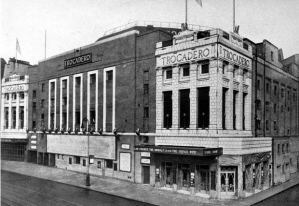
“Rock Around the Clock is playing at the Troc,” was the police constable’s explanation for the huge traffic jam that had paralyzed most of London. The offending cinema was the Trocadero in the Elephant & Castle section of South London. We were driving from West London to Soho, so that we could hang out at the Nucleus—a basement club where jazz musicians jammed all night. At first, it seemed incredible that a single film showing could tie up traffic so completely. But thick fog limited visibility to about thirty yards. And the Troc was a huge grey stone building that occupied an entire city block–with a seating capacity of around 3500.
***
Several years later, we heard that the Troc had closed and was soon to be demolished. That gave us a crazy idea. We had been running parties in vacant buildings ranging from houses to large barns. If we could take over the Troc before it was demolished, we would have our biggest rave yet.
Three major players were involved in the criminal enterprise. Stan, the group’s intellectual, was responsible for organization and promotion. Ken, a big muscular guy, did all the heavy lifting—both literally and figuratively. He was our expert on breaking and entering. Lastly, I organized the music and transportation.
A couple of weeks before the event, Ken broke into the Troc to check it out. The place had been left unlocked for the convenience of the contractors preparing for demolition. The only security was a few chains and padlocks. The seats on the ground floor had all been removed–which would be okay for dancing, though the floor sloped somewhat. Most of the power had been cut off, but there was a temporary supply to provide light for workers and to power their tools. That meant we might have to use musical instruments such as horns that did not require amplification. For lighting we could use kerosene lamps, including a huge red lantern we had stolen from the bridge connecting Eel Pie Island to the shore of the Thames.
After we decided on a date, Stan started promoting the event via the usual grapevine. But because this was going to be our largest rave ever, he decided to promote it on a pirate radio station as well.
The rave started out just fine. There was enough electricity to power the amplifiers for the guitars and singers, and the kerosene lamps provided enough lighting—but with an appropriately spooky atmosphere. A couple of hundred people arrived before the cops shut us down.
Surprisingly, none of the three conspirators were arrested. I had slipped out to get some food and booze for the musicians. When I returned, the place was cordoned off by the police. Early arrivals were detained for questioning. By threatening them with arrest for trespassing, the cops hoped to get them to identify the organizers. Most of the people had merely heard about the rave at their local coffee shop or on pirate radio. A couple of the musicians identified me as their contact—but I wasn’t there and I wasn’t the only named contact. Ken pretended to be just a dancer and to be too dumb to understand the questions.
When the cops arrived, Stan climbed into an empty storage attic over the projection room. He took a bottle of Scotch and a couple of reefers. The police did a pretty thorough search of the building. But they didn’t feel inclined to climb into the attic. Instead, they shoved a police dog up there. The dog found Stan and licked his face. Then Stan filled the ash tray with Scotch and the dog drank it. So Stan kept refilling the ash tray. Pretty soon, the dog got drunk and fell asleep. Eventually, the cops climbed into the attic and dragged out Stan and their dog.
“If you hurt that dog, you can go to jail, because it is the same as assaulting a police officer,” said the police inspector. “In that case, Constable Rover is in big trouble, because he got drunk on the job,” replied Stan. Though the police were pretty sure Stan was an organizer of the rave, they finally released him because they knew his story about the dog would merely amuse a judge and jury.
